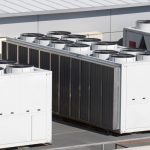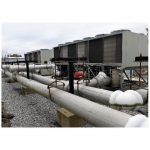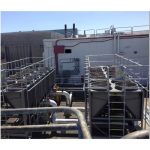Fall Protection for HVAC Chillers
 Industrial size HVAC chillers present multiple fall protection hazards. When located on a rooftop near an unprotected edge, simply approaching the chiller may expose your worker to the risk of falling. Roof edge guardrail, horizontal lifelines, and fixed anchor points can all be designed to protect your workers as they approach and service the lower areas of the equipment. However, from a hazard analysis standpoint, access to the fans from the top of the housing is probably the area with the greatest risk of falling.
Industrial size HVAC chillers present multiple fall protection hazards. When located on a rooftop near an unprotected edge, simply approaching the chiller may expose your worker to the risk of falling. Roof edge guardrail, horizontal lifelines, and fixed anchor points can all be designed to protect your workers as they approach and service the lower areas of the equipment. However, from a hazard analysis standpoint, access to the fans from the top of the housing is probably the area with the greatest risk of falling.
Whether located on a rooftop or on the ground, the top of the chillers is almost always more than four, but less than ten feet above the surface. From an OSHA standpoint, the top deck is considered a work surface, and since the potential fall is more than four feet, the worker must be protected. Also, since the total fall potential is generally less than ten feet, there is almost never enough fall clearance to use an active fall arrest system. Fortunately, there are modular passive solutions available.
Fall Protection Analysis and the Results
 This “before” picture of a recent Fallproof installation shows additional considerations. Chillers come in many sizes, and piping and other obstructions are commonplace around the base. Additionally, any system installed cannot obstruct electrical panels or other areas requiring access.
This “before” picture of a recent Fallproof installation shows additional considerations. Chillers come in many sizes, and piping and other obstructions are commonplace around the base. Additionally, any system installed cannot obstruct electrical panels or other areas requiring access.
For this job, Fallproof took complete measurements of each chiller, noting the location of all service access points, piping and other areas of concern. Multiple locations throughout the manufacturing facility were surveyed. Approval drawings were submitted to the customer, and material was ordered once the system design was finalized.
 This “after” picture of different chillers in the same facility shows the final installation. Because the system was specifically designed from the ground up for this specific location, all piping and other obstructions were designed in. Workers can now access and service the equipment without risk of fall. The safety gate at the top of the ladder results in full perimeter protection. As an added benefit, this passive system required no worker training, no harnesses or other specialized equipment, and no annual inspections, reducing the lifetime cost of protection compared to other alternatives.
This “after” picture of different chillers in the same facility shows the final installation. Because the system was specifically designed from the ground up for this specific location, all piping and other obstructions were designed in. Workers can now access and service the equipment without risk of fall. The safety gate at the top of the ladder results in full perimeter protection. As an added benefit, this passive system required no worker training, no harnesses or other specialized equipment, and no annual inspections, reducing the lifetime cost of protection compared to other alternatives.
Call one of our experts if you would like help in keeping your HVAC workers safe.

